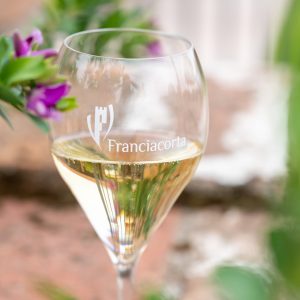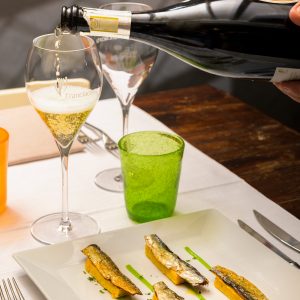Tell us a little bit about who you are, what you do and how you got here.
I am originally from Italy and have been at The Fat Duck for 12 and a half years. I became Head Sommelier in 2018, having started in 2011 as a commis chef due to the language barrier. Back then, there weren’t any sommelier positions available but I really wanted to work with the renowned team, so I just said, ‘give me anything, and I will do it’. I progressed slowly and after two years of working front of house I became chef de rang. However, I still wanted to go back to my true passion: wine.
A sommelier position eventually became available in 2015 and they offered it to me. After a year in Australia – which was a beautiful experience – the Head Sommelier offered me the Assistant Head Sommelier role upon my return. A year later, in 2018, the Head Sommelier left to start other projects, and thought I was ready to take over. I took a leap of faith and embraced the challenge. It was quite scary at first, as it was my first experience as a head sommelier, in a three Michelin-star restaurant in a foreign country! It has been a fantastic journey that has allowed me to learn and grow so much.
What was your first experience with the wines of Franciacorta?
Well, being Italian, Franciacorta has always been part of my life. I studied hospitality and I think I had my first Franciacorta at school. I also have a clear memory of Franciacorta being part of an IS Association (Italian Sommelier Association) competition, which I won at just 16 years of age. After I won we opened a bottle of Franciacorta – it was really remarkable. It is such a good memory and one that has made the wines quite relevant to me from an emotional point of view.
You have been familiar with the wines of Franciacorta for a long time. How have you seen the evolution of the region and the wines?
When I started here, 12 years ago, Franciacorta was well known in Italy, especially in the north, but it wasn’t recognised across the world. Italians have marked their celebrations, like weddings or birthdays, with a bottle of Franciacorta for years, as it is seen as the national sparkling wine of consistently good quality. Today, people know Franciacorta; guests recognise and are open to the name. It’s a beautiful wine and I really like to have it on my wine list.

Do you think people associate quality with Franciacorta wines or do you still need to explain it’s a high-quality traditional method sparkling?
In the past, they might have confused it with other, lesser-quality, sparkling wines from Italy. Today, they are able to really distinguish the nature and quality of wines. They can differentiate between a mass-production wine and a high-quality product, such as Franciacorta. So they perceive and experience it differently.
One might need to give a bit of an explanation – namely about the production method – and then people take it seriously and try it in a different state of mind. I can see that the Franciacortas I have on the wine list are really well perceived. Sometimes, however, even when people are aware that it’s a high-quality wine, they don’t always expect how good it actually is!
How is Franciacorta showcased at The Fat Duck? As a Head Sommelier, how do you position it?
At the moment, we have a couple of Franciacortas on the list but I would like to develop the range. It’s such a nice option to offer by the glass. I change our by-the-glass offering constantly – at the moment I have sparkling sake; before I had Franciacorta. People are very happy to try something other than Champagne. They are curious and when you explain what’s on offer, they are very happy to try a new alternative. I enjoy seeing their surprise and satisfaction.
What are people’s reactions when they see it being poured for them?
Yes, well, sometimes they say things like ‘I can recognise the name but I have never tried it before – so what is it and where does it come from?’. When you can explain what it is, and they are very excited to discover something that they might have heard of but have never tried. When they do try it, they say it tastes delicious – I would even say that people get massively excited about trying it.
Have you ever used Franciacorta as part of food pairings flight?
Yes, for seven years we had Franciacorta as part of the tasting flight. It was lots of fun because people not only enjoyed it but they could see its value as a gastronomic sparkling because of the texture and flavour profile it offers. It pairs really well with a lot of different dishes.
So yes, we have definitely included it in food pairings in the past – and we will have it back on the tasting menu again in the future when we have the right dish. We change the menu quite often (every three or four months), so the wine pairing changes quite often as well. Last year, we had a dish called ‘savoury breakfast’, which we served with Franciacorta… It was such a fun pairing.

Whilst we’re talking about food pairings – can you tell us a little more about it? What’s your view on the pairing potential of Franciacorta wines?
Well it depends on the style of the Franciacorta – whether it’s a Satèn or a Rosé or a Riserva. There’s a very big range of possible pairings. This versatility is what prompted me to serve it with our ‘savoury breakfast’, which was composed of different layers in a pot. You had a scrambled egg panna cotta, mushroom jelly, tomato jam and a cereal that we made with sausage, tomato and mushroom flavours. It was all served with a savoury pan brioche that was accompanied by a tomato and coffee jam and clotted cream to put on top. It really looked like a breakfast meal, with cereal, pan brioche, and a beautiful sparkling wine to go with it.
In a way, it was a classical match because sparkling wine goes so perfectly with breakfast, especially if it’s a savoury dish. However, it’s also about the flavour profile of the wine; the richness of the Franciacorta, the smooth bubbles and the complexity of the wine made it such a good match for the richness and creaminess of the dish. The acidity of Franciacorta cleansed the palate, while the savouriness of the dish went so well with the nutty character of the wine’s oaky flavours.
If you had to pick one style of Franciacorta as a personal favourite, which one would you choose?
I really love Satèn. It’s a very distinctive style, specific to Franciacorta. I love its creamy bubbles, complexity and freshness.
Considering how unique Satèn is – do you think there is a way it can be served that’s different from other sparkling wines?
Satèn is a little bit softer, so I would say it’s perfect as an apèritif. But it also works so well at the end of the meal, to cleanse and refresh the palate. Especially in summer because it has such a refreshing and elegant finish.
It’s also so versatile when it comes to food pairings. It’s perfect with oysters or seafood,and I love it alongside dishes with a little bit of fat – deep-fried foods for instance. Sweetbreads is a great example; a fried sweetbread with its creamy texture but crunchy outside goes so well with a Satèn because of the complexity, softness and freshness of the wine. It’s perfect for dishes like this, that are quite delicate and nuanced in nature.
Discover more about Franciacorta
Connect on
Facebook | Instagram | Twitter | YouTube








